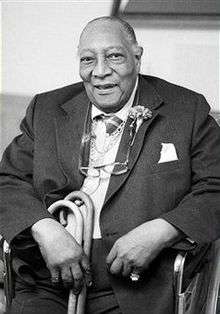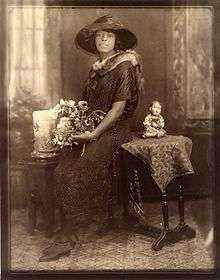James Van Der Zee
| James Van Der Zee | |
|---|---|
 Van Der Zee in 1982 | |
| Born | June 29, 1886 |
| Died | May 15, 1983 (aged 96) |
| Nationality | American |
| Known for | portrait photography |
| Movement | Harlem Renaissance |
| Spouse(s) | Gaynella Greenlee |
James Van Der Zee (June 29, 1886 - May 15, 1983) was an African-American photographer best known for his portraits of black New Yorkers. He was a leading figure in the Harlem Renaissance. Aside from the artistic merits of his work, Van Der Zee produced the most comprehensive documentation of the period. Among his most famous subjects during this time were Marcus Garvey, Bill "Bojangles" Robinson and Countee Cullen.
Biography
Van Der Zee made his first photographs as a boy in. Lenox, Massachusetts. He bought his first camera when he was a teenager, and improvised a darkroom in his parents' home.[1] In 1905, he moved with his father and brother to Harlem in New York City, where he worked as a waiter and elevator operator. In 1915, he moved to Newark, New Jersey, where he took a job in a portrait studio, first as a darkroom assistant and then as a portraitist. He returned to Harlem the following year, setting up a studio at a music conservatory that his sister had founded in 1911.

In 1916, he and his second wife, Gaynella Greenlee, launched the Guarantee Photo Studio on West 125th Street in Harlem. His business boomed during World War I, and the portraits he shot from this period until 1945 have demanded the majority of critical attention. During the 1920s and 1930s, he produced hundreds of photographs recording Harlem's growing middle class. Its residents entrusted the visual documentation of their weddings, funerals, celebrities and sports stars, and social life to his carefully composed images.[2] Among his many renowned subjects were poet Countee Cullen, dancer Bill (“Bojangles”) Robinson, Charles M. "Daddy" Grace, Joe Louis, Florence Mills, and black nationalist leader Marcus Garvey.[1]
Van Der Zee worked predominantly in the studio and used a variety of props, including architectural elements, backdrops, and costumes, to achieve stylized tableaux vivant in keeping with late Victorian and Edwardian visual traditions. Sitters often copied celebrities of the 1920s and 1930s in their poses and expressions, and he retouched negatives and prints heavily to achieve an aura of glamour. He also created funeral photographs between the wars. These works were collected in The Harlem Book of the Dead (1978), with a foreword by Toni Morrison.[3]
In 1969, Van Der Zee gained worldwide recognition when his work was featured in the exhibition, "Harlem on my Mind," at the Metropolitan Museum of Art in New York.[1] As art historian Sharon Patton observed, Van Der Zee not only documented the Harlem Renaissance, but also helped create it.[4]
Photographic techniques and artistry
Works by Van Der Zee are artistic as well as technically proficient. His work was in high demand, in part due to his experimentation and skill in double exposures and in retouching negatives of children. One theme that recurs in his photographs was the emergent black middle class, which he captured using traditional techniques in often idealistic images. Negatives were retouched to show glamor and an aura of perfection. This affected the likeness of the person photographed, but he felt each photo should transcend the subject. His carefully posed family portraits reveal that the family unit was an important aspect of Van Der Zee's life. "I tried to see that every picture was better-looking than the person." "I had one woman come to me and say 'Mr.Van Der Zee my friends tell thats a nice picture, But it doesn't look like you.' That was my style." Said Van Der Zee.[5]
Van Der Zee sometimes combined several photos in one image, for example by adding a ghostly child to an image of a wedding to suggest the couple's future, or by superimposing a funeral image upon a photograph of a dead woman to give the feeling of her eerie presence. Van Der Zee said, "I wanted to make the camera take what I thought should be there." [5]
Van Der Zee was a working photographer who supported himself through portraiture, and he devoted time to his professional work before his more artistic compositions. Many famous residents of Harlem were among his subjects.[3] In addition to portraits, Van Der Zee photographed organizations, events, and other businesses.
Further reading
- Willis-Braithwaite, Deborah; Rodger C Birt (1993). VanDerZee, photographer, 1886-1983. New York: H.N. Abrams. ISBN 0-8109-3923-1.
- Hoving, Thomas (1993). Making The Mummies Dance. New York: Simon & Schuster. ISBN 0-671-73854-2.
- Colin Westerbeck: The James Van Der Zee Studios with an Essay by Dawoud Bey. The Art Institute of Chicago, Chicago 2004, ISBN 0-86559-210-1.
Sources
References
- 1 2 3 Powell, Richard J.; Mecklenberg, Virginia M. (2012). African American art : Harlem Renaissance, civil rights era, and beyond (1. publ. ed.). New York: Skira Rizzoli. p. 223. ISBN 9780847838905.
- ↑ "African American Art: Harlem Renaissance, Civil Rights Era, and Beyond". Google Cultural Institute. Smithsonian American Art Museum. Retrieved 20 February 2016.
- 1 2 Tramz, Mia (February 2014). "Death in Harlem: James VanDerZee's Funerary Portraits". Time Magazine. Time, Inc. Retrieved 20 February 2016.
- ↑ Sharon F. Patton (1998). African-American Art. Oxford University Press. p. 110. ISBN 978-0-19-284213-8.
- 1 2 http://www.scholastic.com/teachers/article/photography-van-der-zee